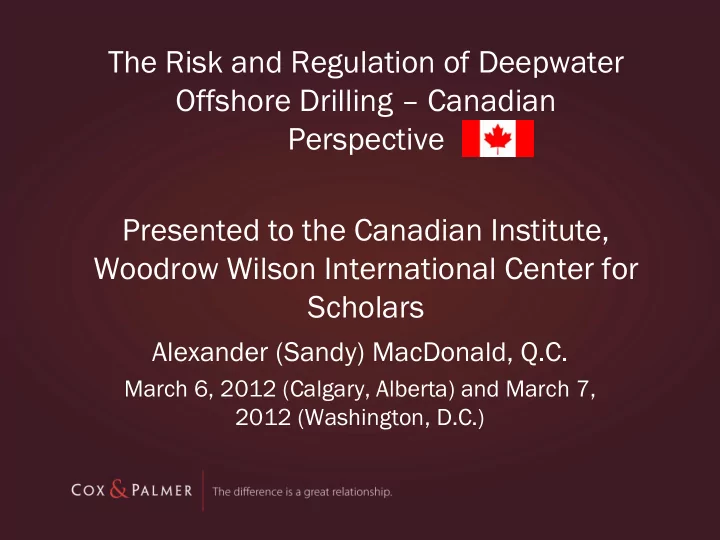

The Risk and Regulation of Deepwater Offshore Drilling – Canadian Perspective Presented to the Canadian Institute, Woodrow Wilson International Center for Scholars Alexander (Sandy) MacDonald, Q.C. March 6, 2012 (Calgary, Alberta) and March 7, 2012 (Washington, D.C.)
Outline • Offshore drilling in Canada • Offshore drilling – the risks • Canadian regulatory approach – British Columbia – Atlantic Canada – Arctic • Managing change and creating a safety culture
Offshore drilling in Canada • Currently conducted primarily in offshore of two Atlantic Canadian provinces – Newfoundland and Labrador, and Nova Scotia • Chevron completed a deepwater well after the Deepwater Horizon in 2,600m (8,535 feet). The well was located 250 miles offshore.
Offshore drilling – the risks • Environmental • Economic • Political • Ethical • Regulatory
Canadian regulatory approach • British Columbia • Atlantic Canada • Arctic
Canadian regulatory approach – British Columbia • Subject to moratorium since 1972 • Federal government has given deference to views of adjacent province.
Canadian regulatory approach – Atlantic Canada • Federal government negotiated deals with two Atlantic provinces in 1980s (Newfoundland and Nova Scotia) • Joint boards established to oversee resources • Negotiations currently underway with Quebec
Canadian regulatory approach - Arctic • Overseen by two federal agencies: – National Energy Board; and – Department of Aboriginal Affairs and Northern Development Canada – North Oil and Gas Branch • The final approach should reflect the wishes of inhabitants of adjacent territories – as with provinces
Managing change and creating a safety culture • Managing change – Even small moves can take a lot of work – Goal from prescriptive regulation • Creating and maintaining a safety culture
Conclusion • Questions?
Recommend
More recommend